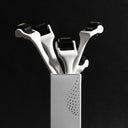Embarking on a low-carb diet often raises questions and concerns, especially regarding its impact on hair health.
This article delves into the intriguing relationship between a low carbohydrate diet and hair loss, a topic of growing interest among health-conscious individuals.
It's common to ponder if modifying one's diet, particularly reducing carbohydrate intake, can lead to hair thinning or loss.
This piece aims to comprehensively understand how a low-carb diet might affect hair health, drawing on scientific insights and expert opinions.
We'll explore the mechanisms behind hair growth, the nutritional aspects essential for maintaining healthy hair, and how altering your diet can influence these factors. W
hether considering a low-carb lifestyle or already immersed in one, this article offers valuable insights and practical advice to help you maintain your dietary goals and hair health.
Table of content
Are low-carb diets bad for hair?

Low-carb diets can potentially lead to hair loss due to nutritional deficiencies. However, this is not a universal outcome and depends on individual dietary choices and overall health.
Low-carb diets often involve reducing the intake of carbohydrates, which can sometimes result in a lack of essential nutrients necessary for hair health. This includes proteins, vitamins, and minerals.
When the body doesn't receive adequate nutrition, it may redirect the limited nutrients available to vital organs, leaving hair follicles undernourished.
This can lead to hair thinning or loss. It's important to note that hair loss due to dietary changes is typically temporary, and a well-balanced low-carb diet that includes sufficient nutrients can mitigate this risk.
As your leading source for hair health information over the past 4 years, we never compromise on accuracy. When it comes to your health, you deserve information you can truly rely on - and earning your trust is our top priority.
Here's how Scandinavian Biolabs ensures every piece of content meets the highest standards of accuracy and integrity:
- Credentialed Experts: Our reviewers are actively practicing doctors and medical researchers
- Stringent Reviews: Content undergoes rigorous editing by subject specialists and review by a practicing doctor.
- Evidence-Based: We rely on well-established research from trusted scientific sources like peer-reviewed journals and health authorities.
- Full Transparency: Our editorial standards, writer credentials, reviewer credentials, correction process, and funding are all publicly documented.
- Independent Voice: While we do promote products, we operate in a vacuum to business operations. Our main goal is just an unwavering commitment to providing medically-sound guidance.
You can count on Scandinavian Biolabs to consistently deliver the trustworthy health information you deserve. Read our Editorial Standards.
How does diet cause hair loss?
Diet plays a crucial role in maintaining hair health. Hair loss can be influenced by nutritional deficiencies or dietary imbalances.
- Protein deficiency: Hair is primarily made of protein. Inadequate protein intake can weaken hair, leading to hair loss.
- Iron deficiency: Essential for hair growth. Low iron levels can disrupt the hair growth cycle.
- Vitamin and mineral deficiencies: Vitamins A, C, D, and E and minerals like zinc and selenium are vital for hair health. Deficiencies can lead to hair loss.
- Rapid weight loss: Sudden weight loss, often due to extreme diets, can cause temporary hair shedding.
- Imbalanced fats: Essential fatty acids, especially omega-3s, are necessary for hair health. Low-fat diets can affect hair quality and growth.
The link between simple carbs and hair loss

Consuming excessive simple carbohydrates may indirectly contribute to hair loss by impacting overall health and nutrient balance.
Simple carbohydrates in foods like sugar, white bread, and pastries can lead to spikes in blood sugar and insulin levels. This can result in inflammation and hormonal imbalances, indirectly affecting hair health.
Additionally, diets high in simple carbs often lack essential nutrients, such as proteins, vitamins, and minerals, for healthy hair growth.
Replacing simple carbs with complex carbohydrates and nutrient-rich foods can help maintain a balanced diet, thus supporting healthier hair growth.
Low-carb diets: are they good or bad for hair loss?
Low-carb diets can contribute to hair loss if they lead to nutritional deficiencies, but they are not inherently bad for hair health when well-planned.
Low-carb diets, which reduce carbohydrate intake, can impact hair health depending on the diet's nutritional balance.
If a poorly planned low-carb diet results in deficiencies in crucial nutrients like proteins, vitamins (especially B vitamins), minerals (such as zinc and iron), and essential fatty acids, it can lead to hair thinning or loss.
However, if the diet is well-structured, ensuring adequate nutrient intake from varied sources, it may not negatively affect hair health.
It's crucial to remember that hair growth is influenced by many factors, including genetics, hormonal changes, overall health, and diet.
Moreover, the initial phase of a low-carb diet can cause a temporary increase in hair shedding due to the body's stress response to a significant change in dietary habits.
This type of hair loss, known as telogen effluvium, is usually temporary and reversible once the body adjusts to the new diet or the nutrient balance is restored.
Can you lose hair on a low-carb diet?
Yes, you can lose hair on a low-carb diet, especially if it leads to nutritional deficiencies. Hair loss on a low-carb diet can occur due to several reasons. First, a drastic change in diet can stress the body, triggering a condition called telogen effluvium, where hair shifts more rapidly into the shedding phase. This type of hair loss is typically temporary and reversible.
Also, low-carb diets can sometimes result in insufficient essential nutrients that support hair health.
This includes proteins, iron, zinc, and B vitamins. Hair follicles require these nutrients for growth and maintenance. When deprived of them, the hair growth cycle can be disrupted, leading to hair thinning and shedding.
To minimize the risk of hair loss, it's essential to ensure that a low-carb diet is balanced and provides a variety of nutrients.
Including a wide range of low-carb protein sources, healthy fats, and nutrient-dense vegetables can help mitigate the risk of hair loss.
If hair loss persists, it's advisable to consult a healthcare professional or a dietitian to assess dietary needs and make appropriate adjustments.
Is low-carb diet hair loss permanent?

No, hair loss from a low-carb diet is usually not permanent. It often reverses once the diet is adjusted to include sufficient nutrients or the body adapts to the dietary change.
Hair loss associated with low-carb diets is typically a result of nutritional deficiencies or the body's response to a sudden change in diet.
This type of hair loss, known as telogen effluvium, involves a temporary shedding phase. Hair growth usually returns to normal once the body receives adequate nutrition or becomes accustomed to the new diet.
Ensuring a balanced diet with adequate protein, iron, zinc, and essential vitamins is important to support hair health. If hair loss continues despite dietary adjustments, seeking advice from a healthcare professional for further evaluation is advisable.
How to treat low-carb diet hair loss?
To treat hair loss caused by a low-carb diet, addressing the underlying nutritional deficiencies and considering hair growth treatments is essential.
Bio-Pilixin Serum

The Bio-Pilixin Serum from Scandinavian Biolabs is a specialized hair care product designed to help promote growth and reduce hair loss. This innovative serum is crafted using a nature inspired, vegan ingredients blend, ensuring a gentle yet practical approach to hair treatment.
Its formula is enriched with nutrients and plant-based components that work synergistically to strengthen hair follicles, enhance hair density, and stimulate new hair growth.
The serum's lightweight, non-greasy texture allows for easy application and rapid absorption into the scalp, providing nourishment directly to the hair roots.
A standout feature of the Bio-Pilixin Serum is its 150-day money-back guarantee, which underscores the confidence of Scandinavian Biolabs in their product and offers customers a risk-free opportunity to experience its potential benefits.
Minoxidil
Minoxidil is a well-known topical treatment used to combat hair loss. It works by stimulating hair follicles, improving hair growth, and slowing hair loss.
It is suitable for both men and women and is available over the counter in various formulations, such as liquids and foams.
Finasteride
Finasteride is a prescription medication primarily used to treat male pattern baldness. It works by inhibiting the hormone responsible for hair loss in men.
Finasteride effectively promotes hair regrowth and slows further hair loss but is not typically recommended for women.
Balanced diet
Ensuring a balanced diet rich in essential nutrients like proteins, vitamins, and minerals can significantly help treat hair loss caused by a low-carb diet. Incorporating various whole foods, including lean meats, fish, nuts, seeds, and green leafy vegetables, can provide the necessary nutrients for healthy hair growth.
Scalp massage
Regular scalp massages can increase blood flow to the hair follicles, promoting hair growth. This simple, relaxing technique can easily be integrated into daily hair care routines.
By combining these treatments and lifestyle changes, individuals experiencing hair loss due to a low-carb diet can see improvements in their hair health.
Conclusion
This article explored the relationship between low-carb diets and hair loss, highlighting that such dietary changes can potentially lead to hair thinning or loss due to nutritional deficiencies.
However, this type of hair loss is usually not permanent and can be reversed with dietary adjustments and appropriate hair care treatments.
A balanced diet, rich in proteins, vitamins, and minerals, is crucial for maintaining healthy hair growth.
For those experiencing hair loss, treatments like Minoxidil and Finasteride and natural solutions like the Bio-Pilixin Serum from Scandinavian Biolabs can be effective.
The Bio-Pilixin Serum, in particular, offers a unique blend of nature-inspired ingredients to help reduce hair loss and promote hair growth, backed by a 150-day money-back guarantee.
FAQs
Can changing my diet reverse hair loss caused by a low-carb diet?
Adjusting your diet to include sufficient nutrients, especially proteins and essential vitamins, can help reverse hair loss caused by a low-carb diet.
Is the hair loss from a low-carb diet permanent?
No, hair loss due to a low-carb diet is typically temporary and can be reversed with proper nutritional intake and hair care treatments.
How does the Bio-Pilixin Serum help with hair loss?
The Bio-Pilixin Serum from Scandinavian Biolabs is formulated with natural, vegan ingredients designed to strengthen hair follicles, reduce hair loss, and stimulate new hair growth. Its effectiveness is supported by a 150-day money-back guarantee, providing a risk-free option for those looking to improve their hair health.
Resources:
- https://pubmed.ncbi.nlm.nih.gov/12196747/
- https://www.ncbi.nlm.nih.gov/books/NBK482378/
- https://www.ncbi.nlm.nih.gov/books/NBK278957/
- https://www.ncbi.nlm.nih.gov/pmc/articles/PMC2938579/
- https://pubmed.ncbi.nlm.nih.gov/2180995/
- https://pubmed.ncbi.nlm.nih.gov/3549804/
Read more:






